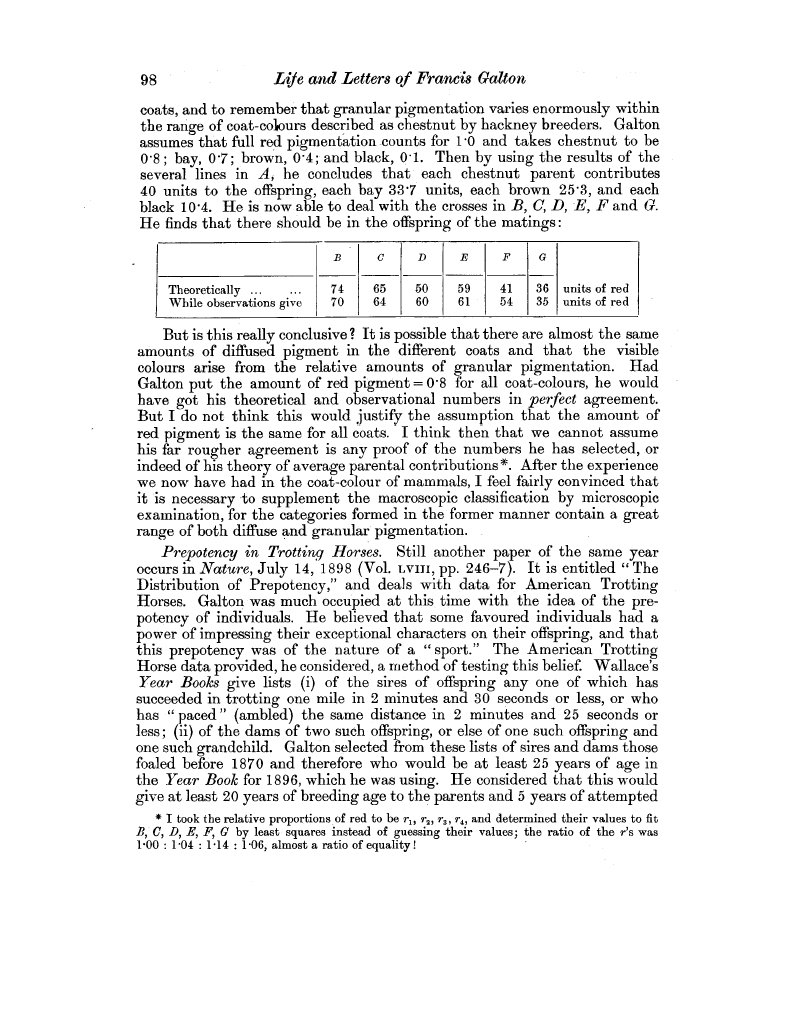| ||||||

OCR Rendition - approximate
98 Life and Letters of Francis Galton coats, and to remember that granular pigmentation varies enormously within the range of coat-colours described as chestnut by hackney breeders. Galton assumes that full red pigmentation .counts for 1.0 and takes chestnut to be 0-8; bay, 0-7; brown, 0-4; and black, 0.1. Then by using the results of the several lines in A, he concludes that each chestnut parent contributes 40 units to the offspring, each bay 33.7 units, each brown 25.3, and each black 10.4. He is now able to deal with the crosses in B, C, D, E, F and G. He finds that there should be in the offspring of the matings
But is this really conclusive? It is possible that there are almost the same amounts of diffused pigment in the different coats and that the visible colours arise from the relative amounts of granular pigmentation. Had Galton put the amount of red pigment= 0.8 for all coat-colours, he would have got his theoretical and observational numbers in perfect agreement. But I do not think this would justify the assumption that the amount of red pigment is the same for all coats. I think then that we cannot assume his far rougher agreement is any proof of the numbers he has selected, or indeed of his theory of average parental contributions*. After the experience we now have had in the coat-colour of mammals, I feel fairly convinced that it is necessary to supplement the macroscopic classification by microscopic examination, for the categories formed in the former manner contain a great range of both diffuse and granular pigmentation. Prepotency in Trotting Horses. Still another paper of the same year occurs in Nature, July 14, 1898 (Vol. LVIII, pp. 246-7). It is entitled " The Distribution of Prepotency," and deals with data for American Trotting Horses. Galton was much occupied at this time with the idea of the prepotency of individuals. He believed that some favoured individuals had a power of impressing their exceptional characters on their offspring, and that this prepotency was of the nature of a " sport." The American Trotting Horse data provided, he considered, a method of testing this belief. Wallace's Year Books give lists (i) of the sires of offspring any one of which has succeeded in trotting one mile in 2 minutes and 30 seconds or less, or who has paced" (ambled) the same distance in 2 minutes and 25 seconds or less; (ii) of the dams of two such offspring, or else of one such offspring and one such grandchild. Galton selected from these lists of sires and dams those foaled before 1870 and therefore who would be at least 25 years of age in the Year Book for 1896, which he was using. He considered that this would give at least 20 years of breeding age to the parents and 5 years of attempted * I took the relative proportions of red to be r1, r2, r,, r4f and determined their values to fit B, C, D, E, F, G by least squares instead of guessing their values; the ratio of the is was 1.00 : 1.04 : 1.14 : 1.06, almost a ratio of equality !
|